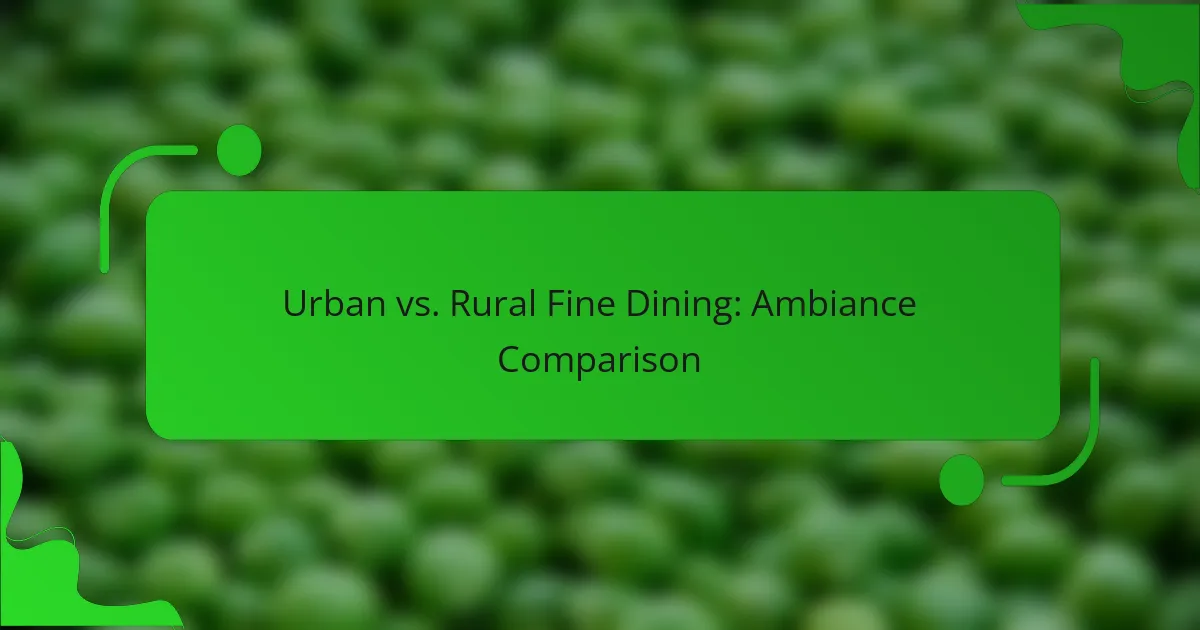The ambiance of fine dining establishments varies significantly between urban and rural settings, each offering a distinct experience. Urban fine dining often showcases sleek, modern designs and a vibrant atmosphere, while rural venues embrace a cozy, rustic charm that highlights the beauty of nature. These contrasting environments not only influence the decor but also enhance the overall dining experience through their unique cultural and environmental elements.

How does urban fine dining ambiance differ from rural fine dining ambiance?
Urban fine dining ambiance typically features sleek, modern designs and a lively atmosphere, while rural fine dining emphasizes a cozy, rustic charm that reflects the surrounding nature. Each setting offers a unique dining experience shaped by its environment and cultural influences.
Urban fine dining features modern decor
In urban fine dining establishments, the decor often includes contemporary art, minimalist furniture, and high-end materials like glass and metal. These elements create a sophisticated and polished atmosphere that appeals to city dwellers and visitors alike.
Lighting plays a crucial role in urban settings, with dim, ambient lighting enhancing the overall experience. Many urban restaurants also incorporate open kitchens, allowing diners to observe the culinary process, which adds to the modern appeal.
Rural fine dining emphasizes rustic charm
Rural fine dining focuses on creating a warm and inviting environment, often using natural materials such as wood, stone, and vintage furnishings. This decor reflects the local culture and heritage, making the dining experience feel more intimate and connected to the surroundings.
Many rural restaurants feature elements like fireplaces, exposed beams, and local artwork, which enhance the rustic charm. The ambiance encourages relaxation and a slower pace, allowing diners to savor their meals in a tranquil setting.
Urban settings offer vibrant nightlife
Urban fine dining is often situated in bustling areas with access to a variety of nightlife options. After dinner, guests can easily transition to nearby bars, clubs, or entertainment venues, making it a lively experience.
This vibrant atmosphere attracts a diverse crowd, contributing to a dynamic dining experience. The energy of the city can enhance the enjoyment of a meal, as diners are surrounded by the sounds and sights of urban life.
Rural locations provide serene landscapes
In contrast, rural fine dining locations are typically surrounded by picturesque landscapes, such as rolling hills, forests, or lakes. This natural beauty creates a peaceful ambiance that allows diners to unwind and connect with nature.
The serene environment often encourages longer meals, as guests can take their time to enjoy the food and the views. Many rural restaurants take advantage of their surroundings by offering outdoor seating, allowing diners to fully immerse themselves in the tranquil setting.

What are the key elements of ambiance in urban fine dining?
The ambiance in urban fine dining is shaped by several key elements, including lighting, music, and interior design. These factors work together to create a sophisticated and inviting atmosphere that enhances the overall dining experience.
Lighting design creates a sophisticated atmosphere
Effective lighting design is crucial in urban fine dining, as it sets the mood and highlights the restaurant’s aesthetic. Soft, warm lighting often creates an intimate setting, while brighter lights may be used to emphasize specific areas or features.
Consider using dimmable fixtures to adjust the brightness according to the time of day or the type of dining experience. For instance, a romantic dinner may benefit from lower light levels, while a lively brunch could use brighter lighting to energize the space.
Music selection enhances the dining experience
Music selection plays a significant role in shaping the ambiance of urban fine dining establishments. The right background music can enhance the dining experience by complementing the cuisine and overall theme of the restaurant.
Choose music that aligns with the restaurant’s concept; for example, a modern bistro might feature contemporary jazz, while a rustic Italian eatery could play traditional Italian tunes. Volume levels should be carefully managed to ensure that conversations can flow comfortably without being drowned out.
Interior design reflects contemporary trends
Interior design in urban fine dining often reflects current trends, incorporating elements that appeal to the target demographic. This can include minimalist designs, sustainable materials, or unique art pieces that create visual interest.
It’s important to strike a balance between aesthetics and functionality. Ensure that the layout allows for comfortable seating and movement, while also showcasing design elements that resonate with diners. Regular updates to decor can keep the ambiance fresh and engaging, encouraging repeat visits.

What are the key elements of ambiance in rural fine dining?
The ambiance in rural fine dining is characterized by a blend of natural elements, local culture, and a relaxed atmosphere. Key aspects include the use of natural materials, scenic views, and the incorporation of local art, all of which contribute to a warm and inviting dining experience.
Natural materials create a cozy environment
In rural fine dining, the use of natural materials such as wood, stone, and linen is prevalent. These elements not only enhance the aesthetic appeal but also create a sense of warmth and comfort. For instance, wooden tables and stone fireplaces can evoke a rustic charm that complements the surrounding landscape.
When selecting furnishings, consider pieces that reflect the local environment. Reclaimed wood or locally sourced stone can add authenticity and connect diners to the region’s heritage. Avoid overly modern or synthetic materials that may clash with the rural setting.
Views of nature enhance the dining experience
Scenic views play a crucial role in the ambiance of rural fine dining. Restaurants often capitalize on their natural surroundings by offering large windows or outdoor seating that allows diners to enjoy landscapes such as rolling hills, forests, or lakes. This connection to nature can elevate the overall dining experience.
To maximize the impact of views, consider the placement of tables and the design of the dining area. Positioning tables to face the most picturesque aspects of the landscape can create a more immersive experience. Avoid obstructing views with tall decor or partitions that detract from the natural beauty outside.
Local art adds cultural significance
Incorporating local art into the dining space not only enhances the ambiance but also celebrates the region’s culture. Artwork from local artists can tell stories and reflect the community’s heritage, making the dining experience more meaningful. This could include paintings, sculptures, or handcrafted decor items.
When choosing art, prioritize pieces that resonate with the local culture and complement the overall design of the restaurant. Regularly rotating exhibits or collaborating with local artists can keep the ambiance fresh and engaging, encouraging repeat visits from patrons eager to experience new works.

How do customer expectations differ in urban vs. rural fine dining?
Customer expectations in urban fine dining often revolve around unique and innovative culinary experiences, while rural diners typically emphasize comfort and traditional cuisine. These differing priorities shape the overall dining atmosphere and menu offerings in each setting.
Urban diners seek innovative culinary experiences
In urban fine dining, customers expect creativity and originality in their meals. This often includes experimental dishes, fusion cuisine, and the use of high-quality, locally sourced ingredients. Diners may be drawn to restaurants that offer tasting menus or chef’s specials that showcase seasonal produce and unique flavor combinations.
Urban establishments frequently focus on presentation and ambiance, enhancing the overall dining experience. Diners often appreciate an engaging atmosphere, which can include open kitchens, artistic plating, and themed decor that reflects current trends.
Rural diners prioritize comfort and tradition
Rural fine dining tends to emphasize hearty, traditional meals that evoke a sense of nostalgia. Diners often seek familiar flavors and comfort foods, such as classic roasts, homemade pastas, or regional specialties. The focus is on satisfying portions and wholesome ingredients that resonate with local culinary heritage.
The ambiance in rural dining establishments typically reflects a cozy and welcoming environment. Many diners appreciate rustic decor, friendly service, and a slower pace that allows for conversation and relaxation. This setting encourages patrons to enjoy their meals without the rush often found in urban restaurants.

What are the pricing differences between urban and rural fine dining?
Urban fine dining typically features higher price points compared to rural establishments. This difference is influenced by factors such as location, ingredient sourcing, and overall dining experience.
Urban fine dining often has higher price points
In urban areas, fine dining restaurants often charge premium prices, reflecting the higher costs of rent, labor, and ingredients. Main courses can range from $30 to over $100, depending on the restaurant’s prestige and the complexity of the dishes.
Additionally, urban fine dining establishments frequently offer elaborate tasting menus, which can further elevate the total cost. Diners should be prepared for a higher overall bill, especially when including drinks and gratuity.
Rural fine dining may offer more affordable options
Rural fine dining establishments generally provide more budget-friendly choices, with main courses often priced between $20 and $50. These restaurants may focus on local ingredients, which can reduce costs and enhance the dining experience.
While the ambiance and service may differ from urban counterparts, many rural fine dining venues maintain high culinary standards. Diners can enjoy quality meals without the steep prices typically associated with city dining.

What factors influence the choice between urban and rural fine dining?
The choice between urban and rural fine dining is influenced by several factors, including accessibility, convenience, and personal preferences for occasion and atmosphere. Each setting offers distinct experiences that cater to different tastes and needs.
Accessibility and convenience play a role
Urban fine dining establishments are typically more accessible due to their proximity to public transportation and a higher concentration of dining options. This convenience can be a significant factor for diners who prioritize ease of access, especially in bustling cities.
In contrast, rural fine dining may require more travel time, which can deter some patrons. However, the journey to a rural restaurant can also be part of the experience, offering scenic views and a sense of escape from city life.
Occasion and atmosphere preferences affect choices
The occasion often dictates the choice between urban and rural fine dining. Urban venues may be preferred for business meetings or special celebrations due to their vibrant atmosphere and sophisticated ambiance. They often feature contemporary decor and lively surroundings.
On the other hand, rural fine dining can provide a more intimate and relaxed setting, making it ideal for romantic dinners or family gatherings. The natural surroundings and quieter atmosphere can enhance the dining experience, appealing to those seeking a peaceful retreat.

How can restaurants enhance their ambiance in urban settings?
Restaurants in urban settings can enhance their ambiance by focusing on unique design elements, effective lighting, and incorporating technology. These aspects create an inviting atmosphere that attracts diners and encourages longer stays.
Incorporate technology for interactive experiences
Integrating technology into the dining experience can significantly elevate the ambiance of urban restaurants. Options include digital menus, augmented reality features, and interactive tables that engage guests and provide a modern touch.
For example, restaurants can use tablets for ordering, allowing customers to customize their meals easily. Additionally, augmented reality can offer visual enhancements, such as 3D representations of dishes, making the dining experience more immersive.
However, it’s essential to balance technology with personal interaction. Staff should remain attentive and available to assist, ensuring that technology complements rather than replaces the human touch in service.



